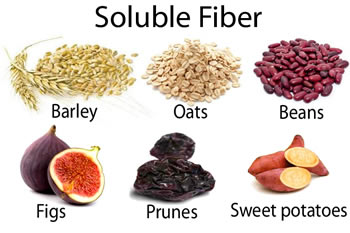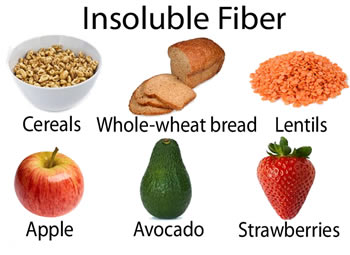Difference between Soluble and Insoluble Fiber
Key Difference: Fiber is a necessary part of any diet. Fiber is actually divided into two main types: soluble fiber and insoluble fiber. The primary difference between the two types of fiber is actually indicated in their names itself; soluble fiber is the one that dissolves in water, whereas insoluble fiber does not.
 It is a generally known fact that fiber is a necessary part of any diet. Humans need to consume an adequate amount of fiber in order to stay healthy; and too little or too much fiber can immediately lead to digestive problems. Fiber has many benefits, such as it helps one feel fuller, hence leading to eating less and consuming lesser calories. However, that is just the tip of the iceberg. Fiber also aids digestion, while also lowering cholesterol, keeping the blood sugar stable, keeping diabetes and obesity at bay, making it easier to lose weight, and even leading to a longer life. What’s not to love about fiber?
It is a generally known fact that fiber is a necessary part of any diet. Humans need to consume an adequate amount of fiber in order to stay healthy; and too little or too much fiber can immediately lead to digestive problems. Fiber has many benefits, such as it helps one feel fuller, hence leading to eating less and consuming lesser calories. However, that is just the tip of the iceberg. Fiber also aids digestion, while also lowering cholesterol, keeping the blood sugar stable, keeping diabetes and obesity at bay, making it easier to lose weight, and even leading to a longer life. What’s not to love about fiber?
While fiber is important as part of the diet, it begs the question, which fiber? Fiber is actually divided into two main types: soluble fiber and insoluble fiber. Both play an important role in digestion and both should be regularly consumed. However, what is the actual difference between them.
The primary difference between the two types of fiber is actually indicated in their names itself; soluble fiber is the one that dissolves in water, whereas insoluble fiber does not. However, this is just one of the many differences between the two. Both also play different types of roles in the digestive process.
As both types of fiber are undigested, i.e. they are not absorbed during the digestion process, they do not enter the bloodstream. Hence, they add zero calories to the calorie intake, while still making the person feel full. They also have numerous added benefits, such as they can also help lower cholesterol, keep blood sugar stable, make it easier to lose weight, and even help one stay alive longer.
Soluble fiber dissolves into water and turns into a gel like substance within the digestive track. It mixes with the food and slows down the digestive process, hence making one stay full for longer. This also slows down the absorption of glucose into the body, hence keeping the blood sugar levels from spiking. Soluble fiber also lowers total and LDL cholesterol, which may reduce the risk of cardiovascular disease.
 Insoluble fiber, on the other hand, not does dissolve in water, and neither does is get absorbed within the body. It literally just passes through the digestive track. However, in doing so, it add bulk to the stool hence making defecation easier. It also helps alleviate constipation.
Insoluble fiber, on the other hand, not does dissolve in water, and neither does is get absorbed within the body. It literally just passes through the digestive track. However, in doing so, it add bulk to the stool hence making defecation easier. It also helps alleviate constipation.
Soluble fiber is primary found in legumes, oat bran, barley, nuts, seeds, beans, lentils, peas, and some fruits and vegetables. Whereas, insoluble fiber is found in foods such as wheat bran, vegetables, and whole grains.
Comparison between Soluble and Insoluble Fiber:
|
|
Soluble Fiber |
Insoluble Fiber |
|
Description |
Is a type of fiber that dissolves in water. It is probiotic and helps better absorption of nutrients. |
Is a type of fiber that does not dissolve in water. It helps in easing defecation. |
|
Key Characteristic |
Dissolves in Water |
Does not dissolve in water |
|
Effect |
Attracts water and forms a viscous gel during digestion |
Moves unaffected through the digestive track |
|
Fermentation |
Is readily fermented. |
Can be prebiotic and metabolically ferment in the large intestine |
|
Benefits |
|
|
|
Available in Foods |
|
|
Reference: Wikipedia, WebMD, MedlinePlus, HealthCastle Image Courtesy: nutrientsreview.com









Add new comment